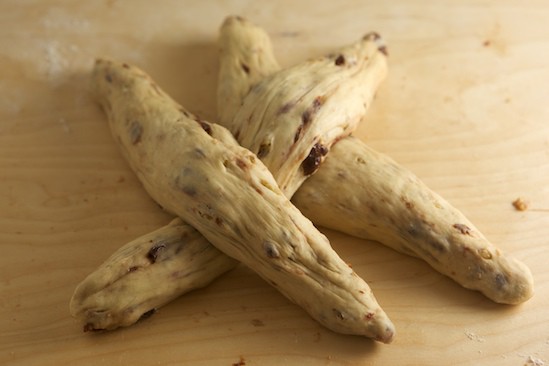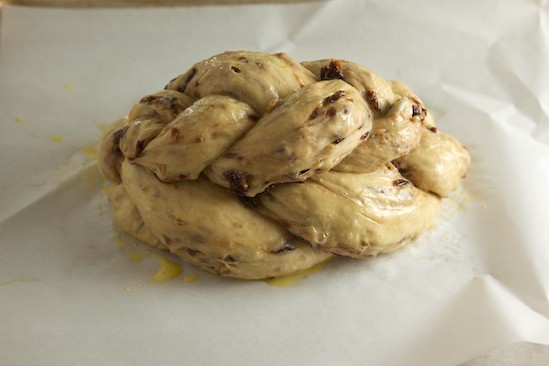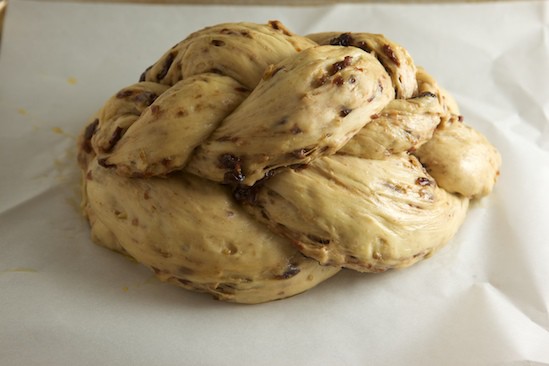
And here comes number eleven!
That’s right, I’m still plugging away at The Bread Baker’s Apprentice Challenge and the next bread up is Cranberry Walnut Celebration Bread. But since Mr. Reinhart gave us the option of choosing different dried fruits and nuts, I decided to celebrate cherry season and use tart dried cherries and pecans in my bread.
Although it is definitely a gorgeous loaf worthy of a celebration, this bread was surprisingly easy to make! No unusual ingredients for this one, just bread flour, yeast, sugar, salt, buttermilk, eggs, butter, water, lemon extract, dried tart cherries, and pecans.

First, the dry ingredients and wet ingredients (except water) are mixed up separately, then combined in one mixing bowl.

I stirred everything together with my trusty wooden spoon, then added enough water to make a soft dough.

Ok, perhaps I added a bit too much water. Don’t panic if this happens, remember that you can always knead in some extra flour during the next step!

Now for the kneading. I decided to give my mixer a day off, so I kneaded this dough by hand on my board. A kitchen counter or smooth tabletop also makes a good kneading surface, you don’t need a pastry board to knead bread dough! But I have one, so I use it. I sprinkled it with a good amount of flour before scraping the sticky mess of dough out of the bowl, floured up my hands, and got to work!

It took about eight minutes of kneading by hand, before I ended up with a smooth, pliable, slightly tacky ball of dough. You really need to make sure that it’s not too stiff at this point, because the nuts and fruit still have to be kneaded in!

I roughly chopped the nuts and cherries before kneading them in. I think this was the first time I’ve ever kneaded dried fruit and nuts into a bread dough by hand, so I was a little unsure about it. I just kind of flattened out the dough and dumped the whole mess on there.

It wasn’t as hard as it seemed. Just be persistant, and it will get incorporated eventually!

Now it’s time for bulk fermentation, the stage where you let the yeast do it’s work and let the ball of dough double in bulk. I cleaned out the mixing bowl, oiled it, and placed the dough inside, rolling it once to coat it with oil. Now, cover the bowl with plastic wrap and let it sit at room temperature for about 2 hours, or until the dough doubles in bulk. If you have a warm house, you will want to check the dough early, because it will rise faster.

Here’s my dough about an hour and a half later. I guess I had some happy yeast!

Now it’s time to divide the dough. For this, I use two important tools: My bench scraper and my digital scale!

Since this is a celebration loaf, it will be shaped into a double braid. There will be a large three-strand braid on the bottom and a smaller three-strand braid on top. This means we’ll need six pieces of dough. Three pieces will be 10 ounces each (for the larger braid) and three pieces will be 4 ounces each (for the smaller braid). Using a scale makes it simple!

Next, the balls of dough need to rolled out into ropes. The book specifies the lengths you need, so a ruler comes in handy at this stage. The larger pieces are rolled to about 9 inches long, while the smaller pieces are about 7 inches long. As you can see, the ropes are thicker in the middle and tapered at the ends. This technique is what helps to form a nice looking braided loaf that is thicker in the center and tapered at the ends.

And now for the braiding. Just like for the challah, I started my braid in the middle and worked out to each end. There are detailed instructions for braiding on page 84 of The Bread Baker’s Apprentice.



After you have braided both the large rope and the small ones, you will place the small braid on top of the large one, making sure it is centered.


Next, brush the entire loaf with an egg wash and let it proof (rise) uncovered at room temperature for about an hour and a half, or until the loaf nearly doubles in size.


After it has doubled, the loaf is carefully brushed with a second egg wash.

Finally, it is baked at 325 degrees for 50-55 minutes, until the loaf is a deep golden brown and sounds hollow when it is tapped on the bottom of the loaf. The internal temperature should be between 185 and 190 degrees. Kind of looks like a roast bird from this angle, doesn’t it?

Although I accidentally baked mine for about ten minutes too long because I forgot to set the timer for an additional five minutes and then got distracted by twitter for fifteen minutes, I was really pleased with this bread!
Like many of the others participating in this challenge, I’m ready for a break from sweet breads and was kind of dreading making another one. But this bread was both beautiful and delicious! And pulling such an amazing loaf of bread from the oven really did fill me with a sense of accomplishment.
I’m glad that I decided to use the tart dried cherries and pecans in this bread, they worked really well together. One thing I might change if I make this bread again is the fruit/nut ratio. I think it could have used a little less dried fruit and perhaps a handful of extra nuts. I think I’ll save the cranberry walnut version for Thanksgiving, it will be perfect for leftover turkey sandwiches!
Interested in making this bread? The recipe can be found on page 154 of Peter Reinhart’s amazing book, The Bread Baker’s Apprentice.
For those of you who are participating in The BBA Challenge, here are some questions: How did you like the Celebration Bread? What type of fruit or nuts did you use? Did you shape it into the double braid or did you choose a different shape? Would you make it again?
And remember, if you wrote a blog post about the Celebration Bread, or have photos available online, please leave a comment and share your link!
The Next Bread
Next we will be making English Muffins! It will be nice to have a break from sweet breads for a little while and I love homemade English Muffins!! The English Muffins are different from the other breads we’ve made so far because they are ‘baked’ on a griddle, rather than in the oven. The instructions begin on page 157 of The Bread Baker’s Apprentice. Good luck and happy baking!
Want to Bake Along With Us?
There are several ways for you to join in the fun! First of all, you need a copy of Peter Reinhart’s The Bread Baker’s Apprentice. Read the first section of the book carefully, as this will prepare you for the bread recipes in the second section of the book. Then just jump in and bake some Anadama Bread, which is the first recipe in the book. But first, please visit The BBA Challenge Page for more details on how to participate in the group!
If you haven’t already, you might want to bookmark the BBA Challenge Page. From there you can see which breads are coming up soon, find answers to Frequently Asked Questions, visit and/or add yourself to our World Map, see the BBA Challenge Blogroll, and check out the continually updated slideshow of BBA Bread photos from our ever-expanding group of bakers!
Celebration Bread from other BBA Challenge members:
- Cranberry Walnut Celebration Bread from Susie’s Home and Hobbies
- Cherry Walnut Celebration Bread from Round the Table
- Cranberry Walnut Celebration Bread from I Can Do That!
- Cranberry Apricot Celebration Bread from 3Sheik
- Cranberry Walnut Celebration Bread from Ahrelich Gesagt
- Strawberry Walnut Celebration Bread from A Stove with a House Around It
- Cranberry Walnut Celebration Bread from Something Shiny
- Peach and Pecan Celebration Bread from Pink Stripes
- Cranberry Apricot Walnut Celebration Bread from Pete Eatemall
- Cranberry Walnut Celebration Bread from Bewitching Kitchen
mmk says
Kener says
Nicole says